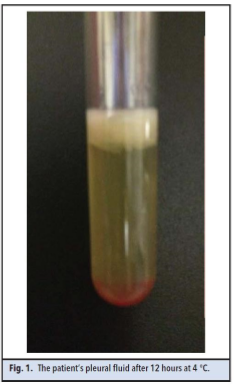Summary
DOI: 10.1373/clinchem.2015.234708
A 90-year-old man was admitted for progressive dyspnea. His medical history included hypertension and chronic myeloid leukemia diagnosed 10 years before and treated with dasatinib. Physical examination revealed pitting edema of the legs and dullness to percussion in the right chest.
Student Discussion
Student Discussion Document (pdf)
Jean-Baptiste Oudart,1,2* Charles Pax,1 Badria Bennani-Smires,1 and Laurent Ramont1,2
1Centre Hospitalier Universitaire de Reims, Laboratoire Central de Biochimie, Reims, France; 2Université de Reims Champagne-Ardenne, UMR CNRS 7369, Matrice Extracellulaire et Dynamique Cellulaire (MEDyC), Reims, France.
* Address correspondence to this author at: Centre Hospitalier de Reims, Avenue du général Koenig, Reims, France 51092. Fax +33-326588539; e-mail [email protected].
Case Description
A 90-year-old man was admitted for progressive dyspnea. His medical history included hypertension and chronic myeloid leukemia diagnosed 10 years before and treated with dasatinib. Physical examination revealed pitting edema of the legs and dullness to percussion in the right chest. Laboratory test results were clinically relevant for white blood cells 7.7 × 109/L (reference interval 4–10 × 109/L), platelets 162 × 109/L (150–400 × 109/L), hemoglobin 10.5 g/dL (13–18 g/dL), total protein 7.1 g/dL (6.3– 8.1 g/dL), cholesterol 154 mg/dL (116–201 mg/dL) [3.99 mmol/L (3–5.2 mmol/L)], triglycerides 122 mg/dL (27–151 mg/dL) [1.38 mmol/L (0.3–1.71 mmol/L)], creatinine 192 µmol/L (45–90 µmol/L), and lactate dehydrogenase (LDH) activity 504 U/L (200–450 U/L). Chest radiograph showed a large right-sided pleural effusion; thoracentesis yielded milky pleural fluid with total protein 4.3 g/dL, LDH activity 291 U/L, cholesterol 66 mg/dL (1.7 mmol/L), and triglycerides 259 mg/dL (2.9 mmol/L). Bacterial cultures had no growth. After 12 h at 4 °C, the pleural fluid had a white ring at the top of the sample (Fig. 1).

Questions to Consider
- What are the steps for evaluating pleural effusions?
- Which diagnosis should be considered in cases of milky pleural fluid?
- What is the main component of the white ring that appeared after 12 h at 4 °C?
Final Publication and Comments
The final published version with discussion and comments from the experts appears
in the February 2016 issue of Clinical Chemistry, approximately 3-4 weeks after the Student Discussion is posted.
Educational Centers
If you are associated with an educational center and would like to receive the cases and
questions 3-4 weeks in advance of publication, please email [email protected].
AACC is pleased to allow free reproduction and distribution of this Clinical Case
Study for personal or classroom discussion use. When photocopying, please make sure
the DOI and copyright notice appear on each copy.
DOI: 10.1373/clinchem.2015.234708
Copyright © 2016 American Association for Clinical Chemistry